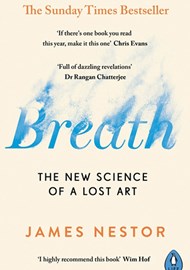‘Popular science’ has become a discrete genre in the publishing world and there seems to be an insatiable desire for well-written books that explain the mysteries of human physiology to ‘lay’ readers. This is one such book, and the author certainly has a gift for conveying complex information in easy-to-digest bite-sized pieces.
The author starts by explaining his visit to a ‘breathing class’. Here, he learned that poor breathing techniques can cause all sorts of all-too-common modern ailments, such as mood swings, dehydration and sleep disturbance. He becomes a willing subject in an experiment to test the effect of prolonged mouth-breathing on his general health. Under the watchful eye of distinguished Stanford rhinologist, Dr Jayakar Nayak, he has his nasal airways temporarily obstructed for a period of 10 days. The results are dramatic. Hypertension, tachycardia, marked sleep apnoea and demonstrable hormonal changes ensue. There is very good evidence of the adverse effects of prolonged mouth-breathing on bringing about facial skeletal and palatal arch changes, and he is greatly relieved when his airway is restored to normal.
The ensuing account is peppered with fascinating anecdotes about historical thinking in different ages and cultures re breathing, including descriptions of techniques such as ‘Tummo breathing’ (an ancient Tibetan technique which is combined with deep meditation), and ‘Helotropic breathing’ (altering the respiratory rate to breathe rapidly for a defined period of time to produce changes in pulmonary oxygenation). A word of caution, these techniques should only be considered under the supervision of a trained facilitator.
Endeavours to ‘train’ the lungs can bring about greatly increased lung capacity. The latter can enable participants to engage in ‘free-diving’ i.e. staying underwater for prolonged periods without the aid of artificial breathing apparatus, but I would counsel extreme caution here.
Many methods to improve how we breathe are described, and these may be of particular interest to patients with respiratory disorders such as asthma.
The author is clearly engaged by the several varieties of meditation and relaxation that involve a focus on breathing, and Buddhist and yoga practices that might benefit many of us are well described.
Some of the literature quoted to support some of these techniques is contentious, and not all of the author’s assertions would be accepted by ‘mainstream’ orthodox scientists, but this was a good read and certainly made this reviewer think about whether ‘common’ or ‘garden’ breathing – and how our patients can improve their breathing techniques – is something that warrants more attention from doctors.





